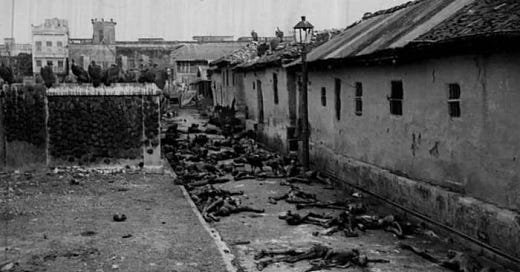When the Streets of Calcutta, India, turned Red.
April-May 1946: After World War Two was over, British India, instead of stabilizing, was undergoing turmoil. Agitations were going on nationwide, industrial unrest and strikes were rampant. The loyalty of the Land Army to the British was in doubt; the Air Force and Navy had rebelled throughout the country.
The Cripps mission sent from England to check the situation on the ground realized that it was impossible to hold India under the British.
Now began the question of whom to transfer the Government. There were huge issues, three of which were First. $5.2 Billion owed to India for supplies, which Britain did not have. Two. Indian Army imposing British Empire in the Middle East and Southeast Asia Three. British investments in India were so big that a loss could have collapsed the London Stock Market
The British solution was to offer power to ALL the political parties for a joint government. That offer was made, but the two leading parties, Congress and Muslim League, could not agree on the terms. Muslim League led by Mohd Ali Jinnah had gained in stature and power in the last five years and claimed representation of all Muslims and wanted equal cabinet berths as Congress, which Congress was not willing to do. While the Muslim League had three chief Ministers in states, the Congress Party had eight. Among the states under Muslim League was Bengal, whose capital was Calcutta.
August 1946: Months of negotiations brought no conclusion. Ultimately, Jinnah decided to come on the street and show his power and declared the 14th of August 1946 as a direct-action day. Exact words: This day, we bid goodbye to constitutional methods.'[i].
This was on the 17th day of the month of Ramadhan and the day the battle of Badr took place, an event of major significance in Muslim history.
The Chief Minister declared a holiday for the police, and they were restricted to their barracks. League supporters started butchery of the innocents on the streets. So much blood flew that Calcutta turned red. In the absence of the Police, a single individual, Gopal Patha, who had nothing to do with politics, organized resistance and counterattack and started saving the hapless. The Hindu counterattack became equally savage.
Chief Minister Suhrawardy now asked the Police and Army to bring the situation under control, which they did. The violence scared the Congress Party to accept most of the Muslim League demands, and they shared a multi-party Government from Sept 1946 to August 1947.
Later, after India was partitioned, he went to Pakistan, briefly becoming its Prime Minister also. Amongst his key supporters was Shaikh Mujibur Rahman, who decades later led the separation of East Bengal from Pakistan, creating a separate country – Bangladesh.
The recently deposed Prime Minister of Bangladesh, Sheikh Hasina, is the daughter of Sheikh Mujibur Rahman.
Historical Events of the Fortnight:
The First Atomic Bomb was dropped on August 6th on Nagasaki in Japan, followed by a second on the city of Hiroshima on August 9th.
Japan declared unconditional surrender on August 15th, and the Surrender was signed on September 2nd, 1945, bringing World War Two to a close.
India became a British Dominion on August 15th, 1947, instead of direct rule by the British Crown. Later, on January 26th, 1950, it ceased to be a dominion and became an Independent Country.
India was partitioned into two parts, India and Pakistan, based on religion on August 14th.
[i] Moon Penderel, Divide and Quit, P 57



